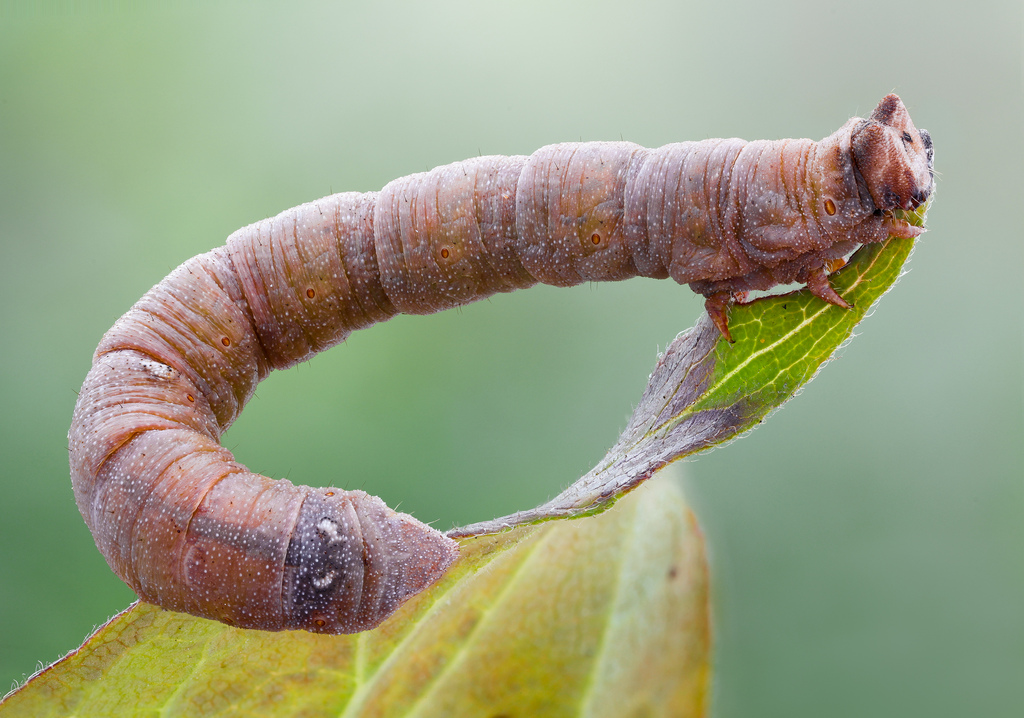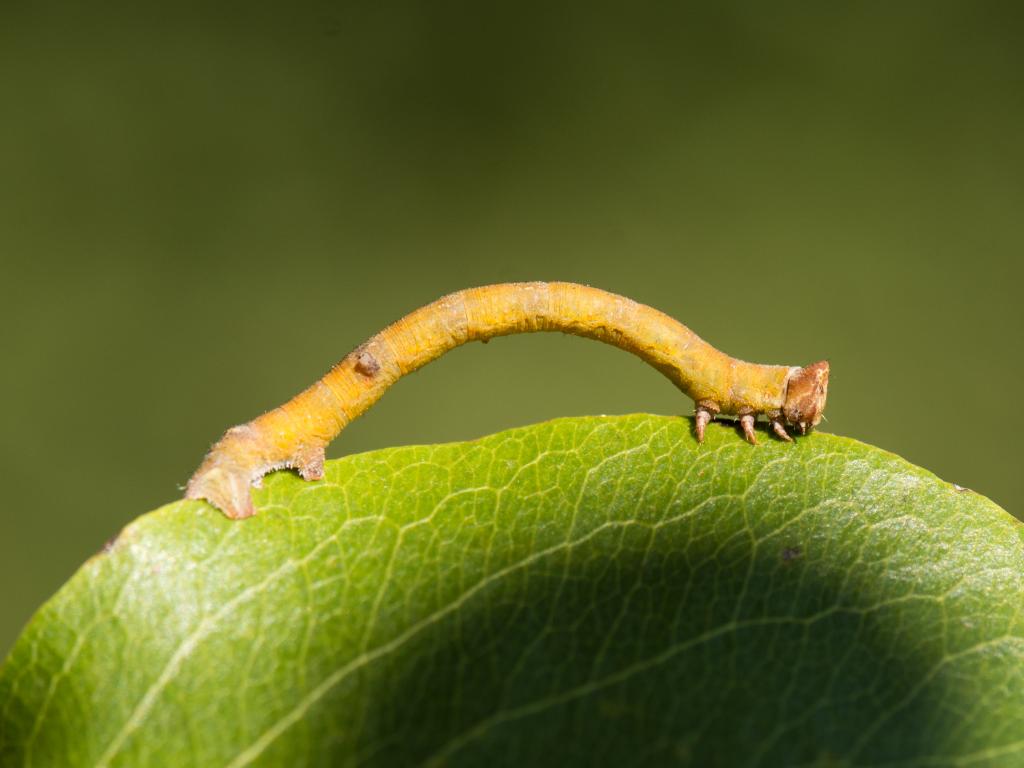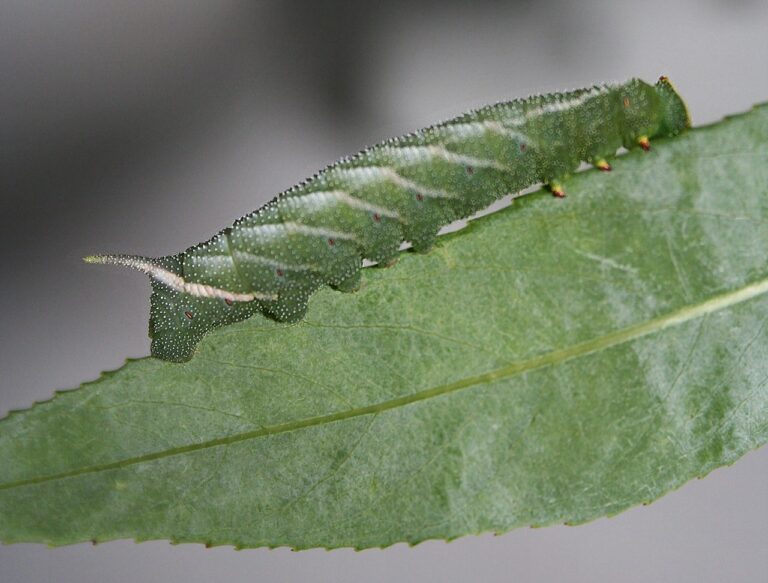Moth larvae, or caterpillars, employ various survival strategies to evade predators:
- They blend with their surroundings, making it hard for predators to spot them.
- Bright colors signal toxicity or unpleasant taste to deter predators.
- Some imitate dangerous creatures to avoid being attacked.
- Spines, hairs, or bristles make them unpalatable or challenging to handle.
- They can secrete noxious chemicals or toxins.
- Silk threads can serve as defense mechanisms.
- Caterpillars may exhibit startling behaviors when threatened.
- Group living provides safety in numbers.
- Many are active at night to avoid daytime predators.
- Some grow quickly, becoming less vulnerable to predators before pupating.
These strategies vary among species, helping caterpillars thrive in their unique environments.
How do caterpillars use camouflage for survival?

Caterpillars employ various mechanisms to achieve camouflage. One common method is to mimic the appearance of leaves or twigs by having body colors and patterns that closely resemble their environment.
In addition, this mimicry extends to the texture and shape of their bodies, making it difficult for predators to distinguish them from real foliage. Some caterpillars even incorporate elements like leaf veins or fake leaf damage into their appearance.
Examples of caterpillar species employing camouflage
Geometrid Moths (Inchworms): Inchworm caterpillars have elongated bodies and a looping gait that mimics the movement of twigs or branches as they crawl. This helps them blend seamlessly with the vegetation they inhabit.
Tailed Emperor Caterpillar: The caterpillar of the Tailed Emperor butterfly is a remarkable example of camouflage.
Moreover, its body has the appearance of a small, spiky, and withered leaf, complete with stem-like appendages at the rear end.
Peppered Moth Caterpillar: The peppered moth caterpillar has a coloration that matches the lichen-covered bark of trees, effectively hiding it from predators when resting on tree trunks.
What is the purpose of warning coloration in caterpillars?
Bright colors in caterpillars often serve as warning signals to potential predators. These colors are typically vivid and contrasting, making the caterpillar highly visible.
Furthermore, the purpose of such coloration is to advertise the caterpillar’s toxicity or unpalatability. Predators learn to associate these colors with a bad taste or harmful effects and, over time, avoid consuming them.
How warning colors deter predators
Warning colors work as a form of defense by reducing predation rates. When a predator encounters a brightly colored caterpillar and attempts to consume it, it may experience a negative outcome such as vomiting or discomfort due to toxins or chemical defenses.
The predator then associates the bright colors with this unpleasant experience and learns to avoid caterpillars displaying similar coloration.
Examples of caterpillars with warning coloration:
Monarch Butterfly Caterpillar: Monarch caterpillars are a classic example of warning coloration with their vibrant stripes of black, yellow, and white. They contain toxic compounds derived from their milkweed diet, making them unappealing to predators.
Hickory Horned Devil: This caterpillar has striking colors with bright green and black spines. These colors signal its unpalatability, and its spines provide additional physical defense.
Swallowtail Butterfly Caterpillars: Many swallowtail caterpillars, like the Eastern Tiger Swallowtail caterpillar, exhibit warning coloration with bright colors and eyespots that mimic larger animals’ eyes, deterring potential predators.
How do caterpillars mimic dangerous animals to avoid predators?
Caterpillars employ various forms of mimicry to deter predators. Some mimic dangerous or intimidating animals, such as snakes, to discourage predators from approaching. Others mimic inedible objects like bird droppings or even parts of the plant they inhabit to avoid detection.
Benefits of mimicry in avoiding predation
Mimicry provides caterpillars with several advantages. When they resemble harmful or unappetizing organisms, potential predators are less likely to attack them, as they may fear harm or discomfort. When they mimic inedible objects or parts of their environment, they become less conspicuous to predators searching for food.
Notable examples of mimicking caterpillars:
Horned Snake Mimicry: Some caterpillars, like those of the Spicebush Swallowtail butterfly, mimic the appearance of a snake.
Furthermore, they have large, false eye spots and a body shape that resembles a snake’s head when threatened. This can deter predators, especially birds, which are natural enemies of caterpillars.
Bird Dropping Mimicry: The Bird-Dropping Caterpillar, as the name suggests, mimics the appearance of a fresh bird dropping. This camouflage helps it avoid detection by predators that would otherwise seek out live prey.
Twig Mimicry: Caterpillars like those of the Common Lascar butterfly resemble small twigs. Their body coloration, shape, and behavior all contribute to this mimicry, making them blend seamlessly with their surroundings.
What are the physical defenses caterpillars use to deter predators?
Caterpillars have evolved an array of physical defenses to deter predators. These defenses can include spines, bristles, hairs, and other structures that make them unappealing or challenging to handle. These structures may be sharp, stinging, or irritating to the touch.
How these structures deter predators
Physical defenses like spines and bristles deter predators by making the caterpillar difficult to consume. When a predator attempts to eat a caterpillar covered in sharp spines or irritating hairs, it may injure its mouthparts or experience discomfort, discouraging future attacks.
Specific examples of caterpillars with defensive structures
Io Moth Caterpillar: Io moth caterpillars have clusters of stinging spines that can cause pain, itching, and skin irritation if touched. This discourages birds and other predators from attempting to eat them.
Saddleback Caterpillar: Saddleback caterpillars possess distinctive saddle-shaped protrusions on their backs, which have venomous spines. Contact with these spines can result in a painful sting, deterring predators.
Tussock Moth Caterpillars: Many species of tussock moth caterpillars have tufts of bristles or hairs that can irritate the mouth and digestive system of predators. These bristles often contain chemicals that add to their defensive capabilities.
How do caterpillars secrete noxious chemicals for defense?
Many caterpillar species have evolved the ability to produce and secrete noxious or toxic chemicals as a defense mechanism.
Moreover, these chemicals are often derived from the caterpillars’ diet, such as consuming toxic plants. The caterpillars store these chemicals in specialized glands and can release them when threatened. Common chemical defenses include alkaloids and glycosides.
Effects of chemical defenses on predators
When a predator attempts to eat a caterpillar with chemical defenses, it may experience various adverse effects. These can range from digestive issues and discomfort to outright poisoning. Predators learn to associate the unpleasant consequences with the caterpillar’s appearance or behavior and subsequently avoid them.
Instances of caterpillars with potent chemical defenses
Tobacco Hornworm Caterpillar: The tobacco hornworm caterpillar feeds on tobacco plants and stores nicotine in its body. Nicotine is highly toxic to many predators, and its consumption can deter birds and other potential threats.
Gulf Fritillary Caterpillar: Gulf fritillary caterpillars feed on passion flower vines and accumulate toxic alkaloids from their diet. Their vivid orange coloration serves as a warning sign to predators, signaling their unpalatability.
Pipevine Swallowtail Caterpillar: These caterpillars consume pipevine plants containing toxic aristolochic acids. They sequester these chemicals and advertise their toxicity through bright colors, discouraging predators from eating them.
What are the various uses of silk threads in caterpillar defense?
Caterpillars produce silk for a multitude of purposes, including creating shelters, binding leaves together to form protective enclosures, and attaching themselves to plant surfaces. Silk also serves as a defense mechanism by enabling them to construct barriers or traps that hinder predators.
How silk contributes to survival
Silk threads can deter predators by creating physical obstacles or by making it challenging for them to access the caterpillar. Additionally, silk can provide a secure hiding place, offering protection from both predators and adverse weather conditions.
Examples of silk-producing caterpillars
Eastern Tent Caterpillar: These caterpillars construct silk tents in the crotches of tree branches where they gather for protection during rest and molting periods. The silk tent acts as a communal shelter.
Bagworm Caterpillar: Bagworm caterpillars construct protective cases made of silk and camouflaging materials like leaves and twigs. They drag these cases with them as they move, providing a mobile shelter and disguise.
Webspinners: These caterpillars live within silk tubes they spin on plants. The silk tubes provide both protection and a means to ambush prey.
How do caterpillars exhibit defensive behaviors to deter predators?
Caterpillars display a range of defensive behaviors when threatened. These behaviors can include thrashing, jerking, regurgitating partially digested plant material, or dropping from their perch. These actions are often startling or off-putting to predators.
How these behaviors deter predators
Defensive behaviors disrupt a predator’s attack, making it less likely for the predator to capture or consume the caterpillar. For example, thrashing or jerking can make the caterpillar difficult to grasp, while regurgitating can release unappealing stomach contents.
Notable examples of caterpillar defensive behaviors
Hickory Horned Devil: When threatened, this caterpillar arches its body and displays its spiky appearance while regurgitating a green liquid, creating a visually unappealing and potentially toxic spectacle for predators.
Swallowtail Butterfly Caterpillars: These caterpillars often exhibit a behavior known as “osmeterium extension.” They extend a forked, orange, Y-shaped structure from behind their heads, releasing a pungent scent that deters predators, particularly ants.
How does living in groups enhance caterpillar survival?
Living in groups, or exhibiting social behavior, provides several advantages for caterpillars. It enhances their collective defense against predators, as there are more individuals to detect and respond to threats. Group members can share information about food sources and potential dangers, increasing the efficiency of foraging and reducing individual risk.
How group living enhances survival
Group living enhances survival by diluting the risk of predation. Predators are less likely to capture any single caterpillar when they are part of a larger group.
Additionally, some caterpillar species engage in cooperative behaviors, such as collectively defending against predators or sharing silk shelters, which further improves their survival chances.
Species known for their social behavior
Eastern Tent Caterpillars: These caterpillars are known for building communal silk tents in the crotches of trees. They gather inside these tents during molting and rest periods, providing protection against predators and adverse weather.
Forest Tent Caterpillars: Similar to eastern tent caterpillars, forest tent caterpillars construct communal silk mats on tree branches. These mats serve as gathering spots for the caterpillars, enhancing their collective safety.
Processionary Caterpillars: Processionary caterpillars are famous for moving in single-file lines, forming long processions. This behavior helps protect them from predators, as the leading caterpillar clears a path while others follow.
Why do caterpillars exhibit nocturnal behavior to reduce predation risk?

Nocturnal caterpillars are primarily active during the nighttime hours. They often rest or hide during the day to avoid diurnal predators and become more active at night when the risk of predation is lower. This behavior includes feeding, foraging, and seeking mates during the darkness.
Why nocturnal behavior reduces predation risk
Nocturnal behavior reduces predation risk because many of the caterpillar’s natural predators, such as birds, are diurnal and less active at night. By adopting a nocturnal lifestyle, caterpillars minimize their exposure to these predators, making it more challenging for them to locate and attack.
Examples of nocturnal caterpillars
Cutworm Caterpillars: Cutworms are a group of nocturnal caterpillars known for feeding on plants at night. They hide in the soil or leaf litter during the day and emerge to feed on plant stems and leaves after dark.
Armyworm Caterpillars: Armyworm caterpillars are primarily nocturnal and exhibit a behavior known as “armyworm marches,” where they move in large groups to feed on crops and vegetation at night.
Looper Caterpillars: Looper caterpillars, such as those of the cabbage looper moth, are often active at night and have a distinctive looping motion as they move.
How does rapid growth benefit caterpillars in terms of survival?
Rapid growth is crucial for caterpillar survival because it allows them to reach a size at which they become less vulnerable to predation before pupating into adult moths or butterflies. Smaller caterpillars are more susceptible to predators, while larger ones may be too challenging for many predators to handle.
How fast growth makes caterpillars less vulnerable
Caterpillars that grow quickly can minimize the duration of their vulnerable larval stage. They can reach a size where their physical defenses, such as spines or chemical defenses, become more effective at deterring predators. Additionally, rapid growth ensures that caterpillars can accumulate enough energy reserves to successfully transition to the pupal stage.
Species that exhibit rapid growth
Luna Moth Caterpillar: Luna moth caterpillars are known for their rapid growth, often attaining a substantial size before pupation. Their large size and bright green coloration may deter many potential predators.
Hawk Moth Caterpillars: Many species of hawk moth caterpillars grow quickly due to their voracious appetite for foliage. They can become quite large and robust before pupating.
Sphinx Moth Caterpillars: Sphinx moth caterpillars, including the tomato hornworm, are recognized for their rapid growth and ability to consume significant amounts of plant material in a short time.
FAQ’s
What adaptation do the moth larvae have to avoid predation?
Moth larvae employ various adaptations for survival, including camouflage, warning coloration, mimicry, and physical defenses like spines or hairs.
How do moth larvae survive?
Moth larvae survive through a combination of strategies such as camouflage, chemical defenses, behavioral adaptations, and rapid growth, depending on the species.
What are two ways that moths use to avoid predation?
Moths use camouflage to blend with their surroundings and warning coloration to signal toxicity or unpalatability as two ways to avoid predation.
What kills moth larvae?
Moth larvae can fall victim to a range of predators, including birds, spiders, wasps, and parasitic insects. Additionally, environmental factors and disease can also contribute to larval mortality.
What do larvae of the moth eat?
The diet of moth larvae varies by species. Some feed on leaves, while others may consume wood, detritus, or even other insects, depending on their ecological niche.
How long can moth larvae live?
The lifespan of moth larvae varies widely depending on the species, environmental conditions, and available food sources. Some may live only a few weeks, while others can exist in the larval stage for several months.
Conclusion
In summary, baby moths, called larvae, have many smart tricks to stay safe from other animals that want to eat them. They can hide by looking like their surroundings, use bright colors to tell predators they taste bad, and even pretend to be something scary.
Some have prickly parts to make it hard for animals to eat them, and some can make yucky chemicals to keep predators away.
In addition, they also make strong silk threads for protection and sometimes live together in groups. Being active at night helps them avoid animals that are awake during the day, and they grow quickly to get big and strong before they change into adult moths.
All these tricks show how clever nature can be in helping animals survive and stay safe from others who want to catch them for food.

